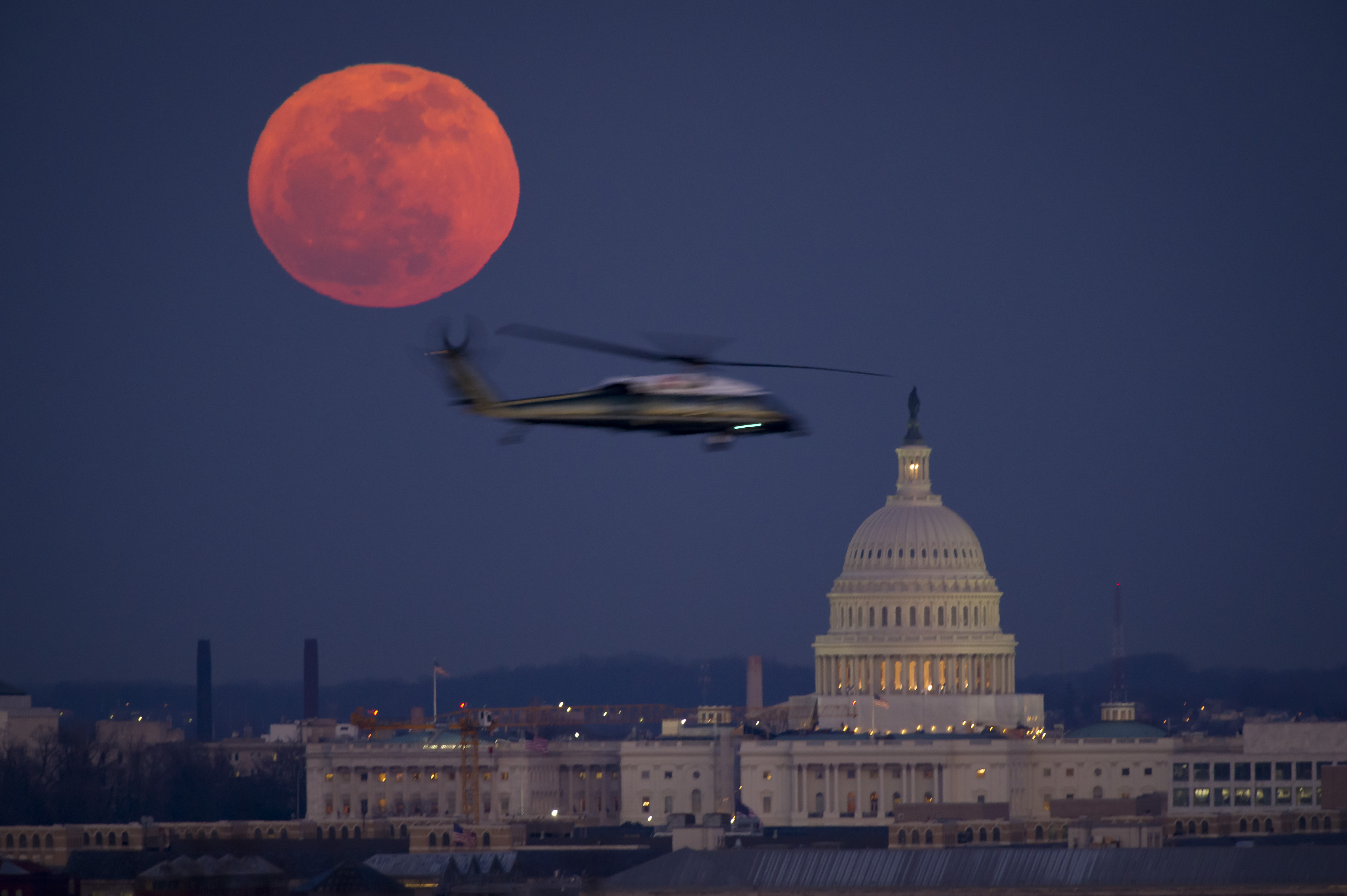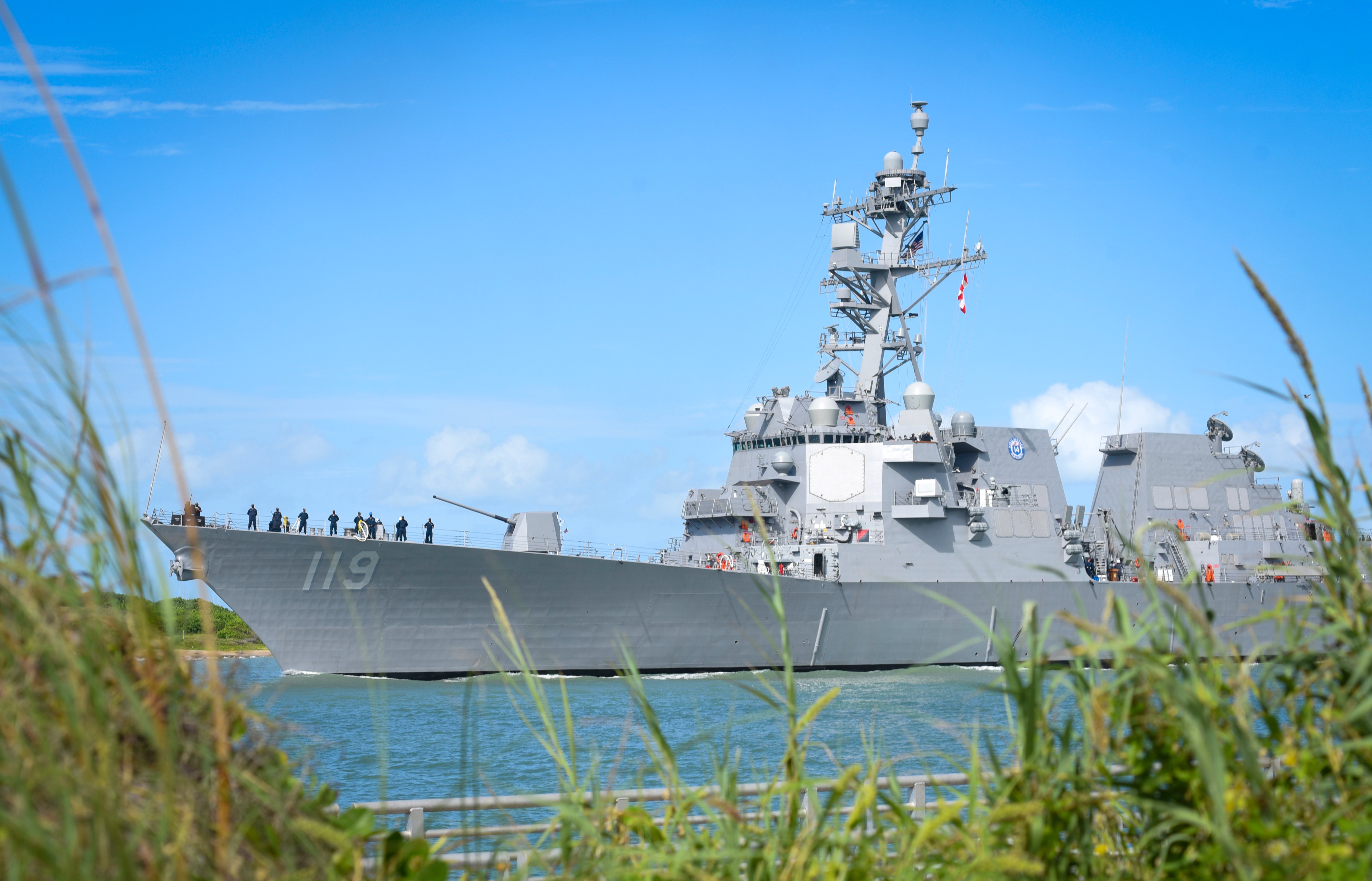
This post has been updated with additional information from the Navy, the Office of Management and Budget and reaction from Congress.
The administration today released a long-range Navy shipbuilding plan that is likely to set up a fight for resources between the Navy and its sister services and between the Pentagon and Congress over how quickly to pursue these changes.
The Fiscal Year 2022 30-year shipbuilding plan, if enacted, would by FY 2025 spend nearly $34 billion a year on shipbuilding, build three attack submarines a year even though industry is currently struggling to build to, buy four Large Unmanned Surface Vessels a year even though Congress isn’t comfortable starting the program of record at all, add a second shipbuilder for the frigate program whose detail design isn’t yet complete, and retire half the cruiser fleet to free up funds for the modernization efforts.
Overall, the ship plan would add 82 new ships in the five years between 2022 and 2026, at a cost of $147 billion. That’s a massive increase compared to previous plans: in February, the Navy projected in its FY 2021 budget request that it would buy just 44 ships from 2021 through 2025, spending $102 billion to do so. The new plan shows an 86-percent increase in the number of ships the service would buy in the next five-year Future Years Defense Program (FYDP), and a 44-percent increase in shipbuilding and conversion account spending.
Included in that greater spending is an increase in attack submarine and frigate construction and the start of light amphibious warship and next-generation logistics ship programs to support new operating concepts.
“I believe we have the body of work that has defined the requirement as best we understand it for the naval force we need to be part of the joint force; we have the acquisition plans to be able to deliver that force; and then we have the resources identified and allocated to finance that at this point in time,” a senior Navy official told reporters today.
“I am very comfortable that we have all of those aligned and synchronized in a way that we have not had in the past with what I believe are reasonable future budget assumptions that are executable.”
A senior administration official told USNI News today that the plan was made with the assumption that the Defense Department would see flat budgets in the coming years that just keep pace with inflation, and that the Navy would see a larger share of the Pentagon budget pie to accommodate increased shipbuilding and the manning, operations and maintenance that go along with the bigger fleet.
Former Defense Secretary Mark Esper by October finally came around to the idea of giving the Navy a larger share of Pentagon funds to grow the fleet, and Chairman of the Joint Chiefs of Staff Gen. Mark Milley said this month that the Army and Air Force would likely see a drop in funding to allow for this modernized fleet that’s optimized for a fight against China or Russia. The senior administration official did not say to what extent the Army and Air Force would see budget reductions to pay for the fleet modernization but did note that a significant amount of funding would be funneled to the Navy as operations in the Middle East wind down. An Office of Management and Budget framework document notes that the plan “reduces Army active duty end strength to 485,000, the Army’s reserve component to 189,500, and the Army National Guard to 336,000, resulting in a savings of $2.6 billion through the next 5 years.”
“Since taking office, President Trump has promised to increase the size of our naval fleet to 355 battle ships, re-establish the United States as the global power at sea to continue to secure our country while making it more prosperous. Today, that promise has been kept. Our updated 30-year shipbuilding plan is a credible, affordable roadmap for achieving maritime supremacy—all while tightening our belts—and sending a strong message to our adversaries like China,” OMB Director Russell Vought said in a statement.
Still, the incoming Biden administration will face immense pressure to address the pandemic and related economic challenges for businesses and families, and it’s unclear if this money tagged for the Navy will remain in their budget.
The Navy was not allowed to release its long-range ship plan earlier this year alongside the FY 2021 budget request, after Esper expressed significant concern with the Navy’s plan to grow and modernize in a cost-conscious way. Esper directed the Pentagon to lead a Future Naval Force Study effort that spanned from about February to October. Esper released his plan to achieve more than 500 manned and unmanned ships by 2045 shortly before being fired by President Donald Trump. The FNFS and the ship plan weren’t released at the time that Esper was verbally touting the outline of his plan, as the White House was still reviewing the plan.
On Wednesday, Vought and National Security Advisor Robert O’Brien released an opinion piece in The Wall Street Journal outlining yet more details of the plan. Today, copies of the long-range plan began circulating among lawmakers.
The senior Navy official said the nine-month FNFS effort really wrung out the Navy’s and Marine Corps’ thoughts on what their future operations would look like and against what enemy. From there, operational plans helped identify capability gaps to get after in this shipbuilding plan.
“Those acquisition plans then were worked iteratively, considering capability, industrial base, timing in terms of relevancy for the distributed fight concepts that the Navy and Marine Corps have been working together, and then from there we priced those acquisition plans and strategies. So we developed the strategy and target, developed the acquisition plans to deliver and sustain those capabilities, and then developed a budget to get there.”
Noting that past plans haven’t always been tethered to long-term budget projections or considerations like sustainment costs, the official said that “what’s different in this plan is we have, I think, a good assumption in terms of what is a reasonable budget in the future and then ensured as we build and deliver these ships that it’s balanced with what it’s going to take to sustain these ships, so that we’ve got a balanced program here.”
The White House labeled this document the FY 2022 plan – noting that it’s not reflective of the FY 2021 plans still waiting to be passed into law on the Hill – though the incoming Biden administration will be the one to submit the FY 2022 spending request and related documents such as this long-range shipbuilding plan.
In the short term, the plan would reach 316 ships by the end of the FYDP, through buying 82 new ships for a cost of $147 billion in these five years but also retiring many legacy ships such as cruisers and dock landing ships. By 2045, the timeframe Esper focused on in his FNFS, the Navy would have 403 manned ships – or 546 manned ships plus unmanned surface and undersea vessels, the report says. By 2051, the end of the 30-year plan, the fleet would have dipped back below 400 ships and then come back up to 405.
Congressional Reaction

Reaction on the Hill to this plan was mixed.
Rep. Joe Courtney (D-Conn.), the chairman of the House Armed Services seapower and projection forces subcommittee, was frustrated that, after four years of the Trump administration stymying efforts to grow the Navy the new plan advocates growing the fleet too quickly.
This year, Courtney said his subcommittee pushed to add more than $5 billion back into Navy shipbuilding plans to address a 17-percent cut the White House had proposed for the Navy shipbuilding account, offering the smallest funding level since 2010.
That budget included building only one Virginia-class submarine in FY 2021 even though the program had been trying to keep at least a two-a-year. Courtney said that Congress had to spend months looking forward offsets and pay-fors within the budget to put that submarine back, with OMB just two weeks ago finally throwing its support behind the second sub.
“It would have been nice to have the Department and the budget office actually engaged in cleaning up the mess they created with their budget,” Courtney told USNI News today.
“That was not an easy task to find that big of a plus-up.”
More broadly he said, this administration has been hampering congressional efforts to grow the attack submarine force for several years. Courtney pointed to a 2018 fight, where he led a bipartisan group of lawmakers in offering an amendment to the defense spending bill to pay for a third submarine in FY 2019, but they ultimately lost the floor vote on the amendment after then- Deputy Secretary of Defense Patrick Shanahan sent a letter objecting to the amendment.
“The administration sabotaged the effort to boost submarine production, and here we are 41 days left in the administration and now they’re lecturing us about the importance of increasing submarine production,” he said.
The chairman said he agrees with much of what’s in the plan – the big picture, at least, if not the specific details – but said time was wasted and that the Navy and its industrial base could have been in a much stronger place today if OMB and the Pentagon had collaborated with him earlier.
On the specifics, Courtney said he’s pleased the plan takes a strong stance on recapitalizing the logistics fleet, but he’s concerned about the details – including the plan calling on the Navy to buy 16 used logistics ships, when the Navy had testified earlier this year that there were only nine in the world that met its needs.

He said he believes in the importance of the frigate program but worries about moving too fast and not learning lessons from past programs like the Littoral Combat Ship. The Navy and builder Fincantieri haven’t even finalized the detailed design yet, but the plan calls for adding a second yard and building four a year by 2025.
“Let’s face it, LCS, they’re still trying to figure out things to do with that,” he said.
He also worries about the Large Unmanned Surface Vessel moving too rapidly.
Despite the over-simplified notion that Congress opposes LUSV, “Congress is not dead-set opposed to unmanned surface ships or even undersea, but I think that this shipbuilding plan basically has funding for production in 2022, and the program is not ready for that, it’s just not.”
Lastly, on sustainment – which would rise from about $30 billion a year today to nearly $130 million a year by the end of the 30 years, according to the Navy’s plan – Courtney questioned whether there was actually room in a realistic budget to support all the new ships the Navy planned to buy.
If Pentagon budgets were to remain flat, as is expected, “there would have to be some real, massive shifting of priorities” between the services, he said.
“I mean, I actually support shifting priorities, but those are big recurring numbers that are going to lock in budgets for decades. As I said, this is not a board game we’re playing here, we’ve got to really have a plan that is balanced and credible, and that’s not what I’m seeing.”
On the other side of the aisle, seapower subcommittee ranking member Rep. Rob Wittman (R-Va.) said in a statement that “this 30-Year Shipbuilding Plan is all about implementing the National Defense Strategy as it pertains to Great Powers Competition,” Congressman Wittman said. “I am pleased with the Navy’s focus on maximizing our asymmetrical advantages with a focus on attack submarines while simultaneously shoring up our weaknesses by increasing our logistics fleet. It appropriately adjusts the 355-ship goal to a force structure that envisions a 403-ship manned requirement with expanded manned and unmanned teaming.”
“While this plan puts our nation on the right track for dominating the seas, we must recognize that we are in a difficult budgeting environment,” he continued. “But one thing is for certain: our budgeting decisions must be as flexible as the strategies we hope to fund, and nothing should be off the table. This 30-Year Shipbuilding Plan is the right plan at the right time. It is good for our nation, our service members, and the Commonwealth of Virginia. I look forward to working with the Navy and the Department of Defense to turn this plan into reality.”
Another subcommittee member, Rep. Elaine Luria (D-Va.), said in a statement to USNI News that “the Navy and the nation are at a critical inflection point. The decisions we make about the future force over the next four years will either set us on a path to maintain maritime dominance or delegate that role to China. This plan grows the fleet in necessary ways to counter the credible threat from China, however, this plan should have been submitted in 2017 and had the appropriate resources behind it to grow the industrial base required for this size fleet,” she said, reiterating Courtney’s frustration.
“The effort by former Secretary Esper to produce this plan should not be wasted and the Navy, Congress, and Biden administration should work together to figure out the best way to fund a larger fleet as quickly as possible. Whether this plan is the right mix of ships and submarines will have to be debated in Congress and proven through wargaming and I look forward to participating in those discussions.”
Courtney said the plan wasn’t dead on arrival. But he said there would have to be serious conversations with Navy uniformed leadership and the new administration in January to make sure lawmakers could take this document and turn it into a plan they were comfortable with, both from a funding and an oversight perspective.
“There’s definitely parts of the architecture that I think a lot of us could embrace. And again, that includes unmanned, that includes trying to recapitalize sealift more aggressively. But the specifics of this plan, it really does come across as a political document and not as a real detailed roadmap for Congress,” Courtney said.
Undersea Warfare

According to the report, “maintaining our undersea advantage is a priority for the Navy. We are in the process of assuring the industrial base capability to continue delivering three SSNs per year past FY26 during Columbia serial production. The post-FYDP SSN profile will continue to be reviewed and updated in subsequent plans as the industrial base assessments are refined with the goal of three SSNs per year, if affordable and supportable by the industrial base.”
The industrial base has never built three Virginia-class SSNs a year and it’s unclear what investments would be needed to help them achieve that production rate while also building the Columbia-class ballistic missile submarine.
The Navy and lawmakers had previously discussed plans of buying as many as 15 SSNs during the current multiyear contract that spans FY 2019 through 2023. Instead, the Navy only awarded a contract for nine, with an option for the tenth – well short of the hoped-for three-a-year rate, or even the possibility of building three in some years when industry could accommodate it. The Navy wanted to include two SSNs in the current FY 2021 budget request, but the Pentagon and White House ultimately took out one submarine, leaving the Navy to request just one SSN while touting the importance of the undersea fight in its future operational plans. The White House ultimately changed its mind this fall, asking lawmakers to include a second SSN in the final FY 2021 authorization and spending bills.
Since the industrial base didn’t use the momentum it had – when it needed to grow to two SSNs and Columbia – to aim for three SSNs a year, it’s unclear if or how quickly the industrial base could again ramp up to achieve three boats a year without harming SSBN construction efforts. SSN deliveries have been delayed for the past several boats, so if the industrial base can’t build two a year without production delays, it’s unclear what would happen if they tried to go to three. The long-range plan also shows SSN procurement in the outyears oscillating between two and three boats rather than staying at three a year consistently, so it’s unclear if that’s due to limitations in industry capacity or limitations of funding, and therefore whether it would be worth it for industry to invest in greater capacity if the Navy wasn’t going to commit to buying three a year for the long-haul.
The report notes the Navy would invest $1.7 billion from FY 2022 to 2024 for shipyard facilitization to enable increased production of SSNs.
Last month, Huntington Ingalls Industries CEO Mike Petters said during a quarterly earnings call that his Newport News Shipbuilding and co-builder General Dynamics Electric Boat, and their supply base, could grow their capacity but would only do so if the Navy was serious about sustained increased production rates over the long term.
“I think the shipyards will have to build, maybe invest in more capacity and more workforce. I think that we’re going to have to create some parallel capacity, maybe think a little bit more about buying pieces that we were doing organically before, maybe structural units or fittings or foundations or something like that. … And then I think you really have to be focused: if you‘re going to get it there, you really have to get the supply chain up to speed. Our supply chain in support of all of shipbuilding, but in particular our nuclear enterprise, it’s very capable, but it’s also kind of thin. So you really need to have a persistent, consistent, sustainable set of messaging to the industry that you’re going to sustain this rate for a significant time to create or attract the investment in technology, capital and people that the supply chain’s going to need to go do,” Petters said.
The senior Navy official told USNI News during a press call, regarding both the Virginia program and others that would be rapidly accelerated in this shipbuilding plan, that “we need to build the industrial base to deliver what the nation needs, not meter what the nation can do based on today’s industrial base.”
“There is capacity available. That doesn’t mean it’s not going to take investment. What this shipbuilding [plan] does perhaps more specifically than previous shipbuilding plans is, we are making targeted and large investments to build the base we need, not just live with the base we have. So there is a large investments in the attack submarine industrial base, north of a billion dollars, $1.7 billion in here, to help get us facilitized, both at the supplier level and then at the shipyard level, to enable us to then deliver at that increased production rate. There are investment in FY ’22 to stand up additional frigate construction capacity, so we get the frigate program similar to DDG-51 where we have multiple yards that can deliver on that ship,” the official continued.
“So we certainly acknowledge, our industrial base is part of our national security. We need to partner, invest and work with that industrial base to create the capacity we need to deliver on this plan. It’s going to take a lot of work. It’s going to take partnership with Department of Labor to build the workforce we need. It’s going to take close partnership with our current providers. It’s going to require not only working with our current suppliers but getting additional suppliers. But I am confident with this demand signal and the resources we’ve laid in, as a country we can certainly achieve this plan — and, I think, in doing so not only increase our current national security through the naval force but actually create jobs and the industrial base, which will have other second and third order effects which will be very beneficial to us.”
Unmanned Vessels

The plan lays out an aggressive schedule for building the Large Unmanned Surface Vessel, the Medium Unmanned Surface Vessel and the Extra Large Unmanned Underwater Vehicle.
According to this plan, by the end of the FYDP the Navy would have bought 12 LUSVs, one MUSV and eight XLUUVs – this despite none of them being programs of record in the procurement phase yet.
The Navy has one MUSV in its Surface Development Squadron-1 in San Diego, with a second on its way. It will by September have taken custody of two LUSV prototypes, which were built by the Pentagon’s Strategic Capabilities Office and are still under SCO command for testing. Boeing started construction of its first XLUUV this fall, USNI News understands, though it previously delivered prototypes for the Navy to begin experimenting with.
Lawmakers have expressed concern the Navy is already planning to move out too quickly on these unproven technologies – especially on the LUSV, which would include missile-launchers for defensive and offensive missions. This plan accelerates them greatly, from one or two LUSVs a year to as many as four a year, which isn’t likely to sit well with Congress.
Surface Ships

This plan would hurry the pace of frigate production – originally planned for a single yard to build nine ships from FY 2020 through FY 2025 – and add a second yard possibly as early as 2023 to achieve a four-a-year rate by 2025.
The plan lays the groundwork for another Arleigh Burke Flight III destroyer multiyear procurement contract in FY 2023 as a bridge between today’s contract and the Large Surface Combatant program, expected to go into detail design in 2026 and start construction in 2028. This plan includes nonrecurring engineering funding starting in 2026.
The plan would start a new Light Amphibious Warship in 2022 and a Next Generation Logistics Ship in 2023 to help the Navy and Marines achieve their Distributed Maritime Operations and Littoral Operations in a Contested Environment concepts for operating against China.
On the traditional amphibious ship side, the plan would accelerate amphibious assault ship LHA-9 acquisition to FY 2022 and ties its funding to three LPD Flight II ships, LPDs 31 through 33. USNI News understands that the Navy and Marine Corps had been eyeing a multiship procurement strategy with these four ships to help accelerate LHA-9, as part of the mitigation strategy for losing USS Bonhomme Richard (LHD-6) to a fire this summer.
The plan would also buy a new class of submarine tender starting in 2024.
Some legacy systems would be retired early to help pay for all these new investments. Ten of the 22 cruisers would be retired in the FYDP – something Congress has not allowed the Navy to do in the past – as would several LSDs.
Still, the report projects that Navy operations and sustainment costs would quadruple over these 30 years as the fleet grows from about 300 manned ships to about 400.





